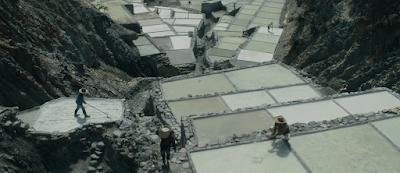Spotlight on Alonso Ruizpalacios:
Güeros (2014)
Museo (2018)
A Cop Movie (2021)
La Cocina (2024)
The four films cover teenager/college life, a museum heist,
police force and restaurant kitchen service respectively. On the surface, all
these four films cover different topics but all four are united by their depiction
of an institution as an insider. All four also have a layer of humour, subtle
in the first three and outright absurd in La Cocina.
An Insider’s view
Güeros shows a slacker kind of life with the
main characters (initially three male but joined by a female later on) drifting
around the city in their car in search of an old Mexican singer (the singer’s
music cassettes changed the lives of two characters) while stopping off at the university amidst
the student protests taking place. The college sequences offer that insider view
of youth and ideology packed with snippets of conversation about revolution,
changing the world and some heated arguments.
Museo is incredibly based on a real story and
is one of those films which highlight that “fact is stranger than fiction”.
The film shows a highly unorthodox museum heist committed by two friends Juan
(Gael García Bernal) and Benjamín Wilson (Leonardo Ortizgris). The humour in
the film is muted at first but increases after Juan and Benjamín make their way
across Mexico trying to sell the stolen museum artefacts. The entire scenarios
around the post-heist defy believe but it also speaks to the fact the two friends
aren’t professional thieves. They are ordinary citizens who are aware of
crossing the morality line and their nervousness feeds into the humorous aspect
of the film. The film isn’t just a recreation of real events but illustrates
the inner workings of a museum and the art-world: museum security, different
exhibits layout, how art is procured, the trading and underground selling/buying
of artefacts, evaluation of art. The film shows how taste is created and what
goes into making a cultural institution.
A Cop Movie is a docu-drama that depicts the
hard life of police force from the intense training they undertake to the
dangers that await officers on the beat. In the first half, A Cop Movie
follows two police officers going about their daily shifts and then in the
second half, the film shows the training the duo underwent. There is a
deliberate blurring of lines between documentary and fiction and that is part
of the film’s overall film-within-film framework. The meta reference also has
something to say about acting and what it takes to prepare for a role. In this
regard, the film highlights the rules, hierarchy, training and expected
behaviour that comes with being part of law enforcement and actor.
La Cocina depicts the intense stressful
environment of a kitchen struggling to keep the food assembly line moving. The
film is not cinema verité but more of a theatrical piece, which is highlighted
by the dance like precision required to get the dishes out. The theatrical
elements truly unfold in the film’s final third when any semblance to drama is
thrown out while the absurdity, satire and soda gushes out from all corners. The
restaurant in the film is high-end or mid-tier pretending to be high-end. Either
way, the film takes pleasure in poking at the inner workings of such a kitchen
and the eccentric personalities that can withstand the constant pressure cooker
environment. Anthony Bourdain would have approved of many aspects of the film.
Contemporary Mexican Life
Three of the films look at Mexican society from different
angles / professions. Güeros looks at teenagers & college
students, with protests / revolution & music thrown in for good measure; Museo
is about young adults trying to make a living, middle class life and
the expensive world of art; A Cop Movie is about the tough law
enforcement life including people from multiple financial backgrounds. La
Cocina is set in New York but the kitchen has plenty of Mexican &
Latin staff, once again confirming what Anthony Bourdain wrote about back in
the day in Kitchen Confidential. In that sense, La Cocina shows
that job some Mexicans find when they make their way to the US.
Each film is piece of the larger Mexican society jigsaw
puzzle that Alonso Ruizpalacios is putting together. Law Enforcement is covered
in A Cop Movie but none of the films are about drug cartels, gang
violence or sex, topics that are normally covered in many other films set in
Mexico. It is commendable that Ruizpalacios has focused on other aspects of
Mexican life.
All four films are presented with a layer of humour that is a few notches above a deadpan style like that in an Aki Kaurismäki film. The exception is the final third of La Cocina when the humour reaches a frenzied chaos. This light comedic style works nicely in Museo as this keeps the film in harmony with the entire absurdity of the heist and proceeding events. However, in the case of Güeros, A Cop Movie and La Cocina, the style coupled with the extra-baggage of these films (story segments, treatment) takes away from the film’s core focus and results in a muddled tone. In addition, this style along with the film topics means that none of the films have a piercing emotional impact like those of other contemporary Mexican directors such as Alejandro González Iñárritu, Amat Escalante, Carlos Reygadas, Michel Franco.









